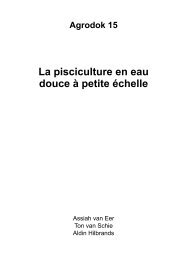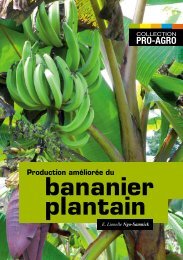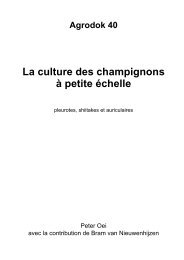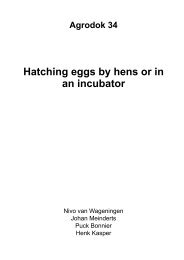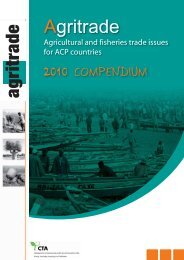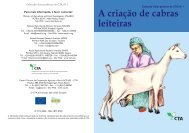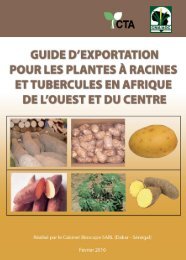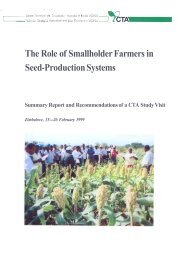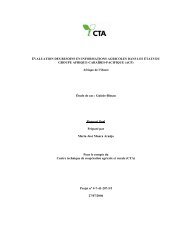La conservation du poisson et de la viande - Anancy
La conservation du poisson et de la viande - Anancy
La conservation du poisson et de la viande - Anancy
- No tags were found...
You also want an ePaper? Increase the reach of your titles
YUMPU automatically turns print PDFs into web optimized ePapers that Google loves.
7.5 Pâtes <strong>de</strong> <strong>poisson</strong> <strong>et</strong> <strong>poisson</strong> entierDans certains pays d’Asie, les pâtes <strong>de</strong> <strong>poisson</strong> représentent unesource considérable <strong>de</strong> protéines ; elles sont plus importantes <strong>du</strong> point<strong>de</strong> vue nutritif que les sauces <strong>de</strong> <strong>poisson</strong>. Dans le Sud-Est asiatique, ilen existe <strong>de</strong>ux sortes :1 mé<strong>la</strong>nges <strong>poisson</strong>-sel2 pro<strong>du</strong>its fermentés avec <strong>du</strong> riz cuit ou grillé sur lequel sont présentes<strong>de</strong>s moisissures <strong>et</strong> <strong>de</strong>s levures.Le procédé général <strong>de</strong> fabrication <strong>de</strong>s pâtes <strong>de</strong> <strong>poisson</strong> est le mêmeque celui <strong>de</strong>s sauces. Mais <strong>la</strong> <strong>du</strong>rée <strong>de</strong> fermentation <strong>de</strong>s pâtes est pluscourte car toute <strong>la</strong> chair <strong>de</strong> <strong>poisson</strong> n’a pas besoin d’être dégradée. Ilfaut remuer régulièrement <strong>la</strong> pâte pour assurer une bonne répartition<strong>du</strong> sel.Sud-Est asiatique :BagoongLe bagoong est une pâte <strong>de</strong> <strong>poisson</strong> originaire <strong>de</strong>s Philippines. Ils’obtient par <strong>la</strong> fermentation <strong>de</strong> <strong>poisson</strong>s bien n<strong>et</strong>toyés, entiers oumoulus, <strong>de</strong> crev<strong>et</strong>tes ou <strong>de</strong> frai <strong>de</strong> <strong>poisson</strong> ou <strong>de</strong> crev<strong>et</strong>te, en présence<strong>de</strong> sel (1 kg <strong>de</strong> sel pour 3 kg <strong>de</strong> <strong>poisson</strong>). Le mé<strong>la</strong>nge sel-<strong>poisson</strong> estmis dans <strong>de</strong>s pots <strong>de</strong> terre cuite recouverts d’un linge (<strong>de</strong> mousseline<strong>de</strong> coton) pendant 5 jours. Puis, les pots sont scellés <strong>et</strong> exposés au soleilpendant 7 jours. Ensuite, le pro<strong>du</strong>it continue à fermenter pendant 3à 12 mois dans un endroit frais. Comme pro<strong>du</strong>it secondaire <strong>du</strong> bagoong,le patis (sauce <strong>de</strong> <strong>poisson</strong>) s’obtient en recueil<strong>la</strong>nt le liqui<strong>de</strong>qui surnage. On peut colorer <strong>la</strong> pâte en ajoutant <strong>de</strong> l’"angkak", riz traitéavec Monascus purpureus, un organisme levuré <strong>de</strong> couleur rouge.Le bagoong se conserve pendant plusieurs années.Ba<strong>la</strong>o-ba<strong>la</strong>oLe ba<strong>la</strong>o-ba<strong>la</strong>o est un pro<strong>du</strong>it originaire <strong>de</strong>s Philippines. C’est un mé<strong>la</strong>ngefermenté riz-crev<strong>et</strong>tes. On mé<strong>la</strong>nge <strong>du</strong> riz cuit, <strong>de</strong>s crev<strong>et</strong>tes entièrescrues <strong>et</strong> <strong>du</strong> sel (20% <strong>du</strong> poids <strong>de</strong>s crev<strong>et</strong>tes). Le mé<strong>la</strong>nge est p<strong>la</strong>cédans <strong>de</strong>s pots où il fermente pendant 7 à 10 jours. Plus <strong>la</strong> <strong>du</strong>rée <strong>de</strong>62<strong>La</strong> <strong>conservation</strong> <strong>du</strong> <strong>poisson</strong> <strong>et</strong> <strong>de</strong> <strong>la</strong> vian<strong>de</strong>




